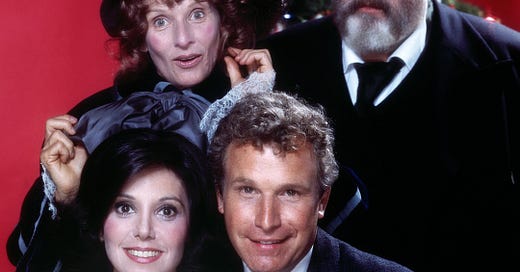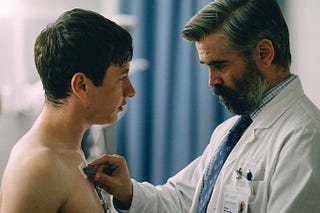
What if They Remade ‘It’s A Wonderful Life’ and No One Remembered It?
In 1977, Marlo Thomas played Mary Bailey in a star-filled alternate-universe version of ‘It’s a Wonderful Life’ that’s essentially been erased from memory.
In 2013, Variety ran a story with a headline so alarming it quickly made its way across a panicked internet: “It’s a Wonderful Life Sequel in the Works.” Bearing the title It’s a Wonderful Life: The Rest of the Story,” the film was to star Karolyn Grimes, the actress who played George Bailey’s flower-toting six-year-old daughter Zuzu in the original, as an angel and an actor to be named later as George’s grandson (also named George). Each new detail about the project made it look increasingly unlikely. Grimes had no credits listed on the IMDb after 1954. (She’s since appeared in a pair of obscure projects.) No director was attached to the film, but it did have a screenplay by Nashville-based producer Bob Farnsworth and Martha Bolton. (Who? Good question.) Combined, the story sent up more red flags than a meeting between the ambassadors of Canada and the People’s Republic of China.
Nonetheless, it quickly became one of those “Can you believe it?!?” stories that seemingly everyone knew about, even if Paramount’s quick assertion of a copyright claim made The Rest of the Story sound less like an in-development movie than an act of fan fiction that spun out of control. It’s not hard to figure out why this news was created, however: You don’t mess with It’s a Wonderful Life.
The Reveal is a reader-supported newsletter dedicated to bringing you great essays, reviews and conversation about movies. While both free and paid subscriptions are available, please consider a paid subscription to support our long-term sustainability.
After opening in limited release at the end of 1946 before going wide in January 1947, Frank Capra’s beloved classic underwhelmed at the box office. Though never obscure and rightly regarded as classic by those who knew it, the film scored an unexpected afterlife when its copyright lapsed in 1974. That allowed both cable and local stations to play it for free. And play it. And play it, bringing a Christmas story that plunges James Stewart’s George Bailey deep into despair before rescuing him by making him see the value of his own life, to virtually anyone flipping through the channels, until it was clawed back into copyright in the early 1990s.
The film’s canonization-through-syndication was still in its early stages in 1977 when an ABC TV movie did the now-unthinkable: it messed with It’s a Wonderful Life.
Sort of: more accurately, the movie remade It’s a Wonderful Life, with a twist. In place of George Bailey, its protagonist would be Mary Bailey, played by Marlo Thomas in her most significant starring role since the final season of That Girl in 1971. Most other changes would be minor except for the title, which became It Happened One Christmas (perhaps an attempt to pay homage to two Capra movies at once).
It’s worth considering how the significance of swapping genders was viewed at the time. After ending That Girl, the first sitcom about a single woman being okay about making it on her own, Thomas’s projects included Free to Be… You and Me, which brought lessons of tolerance and equality, including sexual equality, to a generation of school kids. Thomas was an unabashed feminist, which led It Happened One Christmas to be treated as an extension of these beliefs.
“What’s this? Marlo Thomas carrying women’s lib too far?,” Kay Gardella asks in the first sentence of a New York Daily News profile ahead of the film’s debut. (She’s either joking or laying the groundwork for the Ghostbusters 2016 discourse decades ahead of its debut.) For the most part, Thomas stressed the similarities between her version and the original rather than the differences. “I love it rewritten for a woman,” she told the Associated Press. “The pressures are different but when you wish you’d never been born it doesn’t matter if you’re man, woman, or frog.”
Successful enough to be rerun on ABC the next two years, It Happened One Christmas has since fallen into obscurity (though it can be found on YouTube). The main reason for this is pretty obvious: It’s a Wonderful Life exists and (for a while at least) could be broadcast for free. Why not watch that instead?
It Happened One Christmas doesn’t itself make a particularly compelling argument to the contrary, but it’s fascinating in its way, particularly if you’ve seen It’s a Wonderful Life many times. (And at this point who hasn’t?) Directed by Donald Wrye, who’d have a big theatrical hit with Ice Castles the following year, it’s reverent to its source material almost to a fault. George Bailey’s story becomes Mary Bailey’s story almost to the smallest detail, though the variations suggest it might have been a better movie if more had been done with the gender swap. Mary’s husband—named George, of course, and played by Wayne Rogers—goes off to fight in World War II, leaving her to tend to Bedford Falls business on her own. When Mr. Potter (played with gum-smacking villainy by Orson Welles) offers her a chance to sell out and work for him at a handsome rate, she’s just learned she’s pregnant, making her decision to resist Potter’s appeal all the bolder.
As for the rest, it’s much the same but lesser, though the cast alone keeps it interesting. If never able to tap into the dark reaches plumbed by Stewart, Thomas makes for an appealing lead (though Rogers is pretty drippy as George). Christopher Guest shows up as Harry Bailey, Doris Roberts plays their mom, Seinfeld’s Barney Martin plays Uncle Billy (here “Uncle Willie”), and that’s the voice of Charles Grodin as Joseph, the heavenly official who reluctantly assigns the hapless, wingless angel to the Bailey case. She’s named Clara and played by Cloris Leachman, who goes big, because why wouldn’t you if you were playing that role?
It’s also, and this is hard to overstate, a beautiful-looking film, thanks to cinematography by the great Conrad Hall, whose atmospheric lighting and graceful compositions suggest he didn’t know he was making a TV movie. But even Hall’s work doesn’t allow It Happened One Christmas to shake off a sense of deja vu created by elements other than its plot. As with the original, its dance scene takes place in the swimming pool/gymnasium of Beverly Hills High School, the same location as the original. And though there was no way for the film to know this at the time, its Bedford Falls uses the same town square set soon to be used by both Gremlins and Back to the Future, a spot that would become as iconic as the original Bedford Falls set constructed on the RKO movie ranch.
It Happened One Christmas isn’t bad, just unnecessary, a sense reinforced by the decision to set it in the same era as Capra’s original. It’s a Wonderful Life reflected on the preceding decades’ most dramatic turns, including the Depression and World War II. The film’s timeliness and acknowledgment of how frequently recent events threatened to swallow up the picturesque small-town of Bedford Falls and all the American towns it stood in for gives it a charge this remake never finds. But imagine for a moment a version that did move time forward. Instead of bank runs and air raid drills, Bedford Falls is torn apart by the JFK assassination and the Vietnam War—or it would be if it weren’t united by the decency and common sense of a put-upon protagonist whose lives touched so many. Except that wouldn’t work either, would it?
The politics of It’s a Wonderful Life’s script tilted left. Capra’s politics tilted all over the place over the years, but mostly veered rightward, sometimes right enough to admire Franco and Mussolini in the years before World War II. But the film celebrates the American qualities the nation could agree it shared at the end of a struggle against unspeakable evil that gave us common cause (and prompted Capra to enlist and make the Why We Fight series). It’s a Wonderful Life belongs to its moment and it’s hard to imagine it working in any other time or place. It might be best left alone. A sequel makes little sense and any remake is sure to be overshadowed. That includes this earnest but misguided attempt, a TV oddity from the auld lang syne known as the 1970s destined to be forgotten and rarely brought to mind.
















Wow, that's so fascinating that the whole reason for the "It's a Wonderful Life" phenomenon is because of a copyright that lapsed! I always wondered how it became a yearly staple on TV (and now in repertory movie theaters too) when it didn't do very well at the box office when it was released. It goes to show how random it can be which movies have a lasting cultural memory and which ones fade into obscurity.
I'm also blown away that Orson Welles of all people was in a remake of It's a Wonderful Life!
The Christopher Guest connection is interesting in light of the fact that he slipped a parody of IT’S A WONDERFUL LIFE into his 1989 film THE BIG PICTURE during a scene where Kevin Bacon’s would-be director is drowning his sorrows at the local bar (and bending the ear of the bartender played by John Cleese). The capper comes when the film returns to reality, with Bacon watching the movie on the bar’s TV, only for Cleese to hit the set to make the picture switch from black and white to color. “That’s better,” he says.